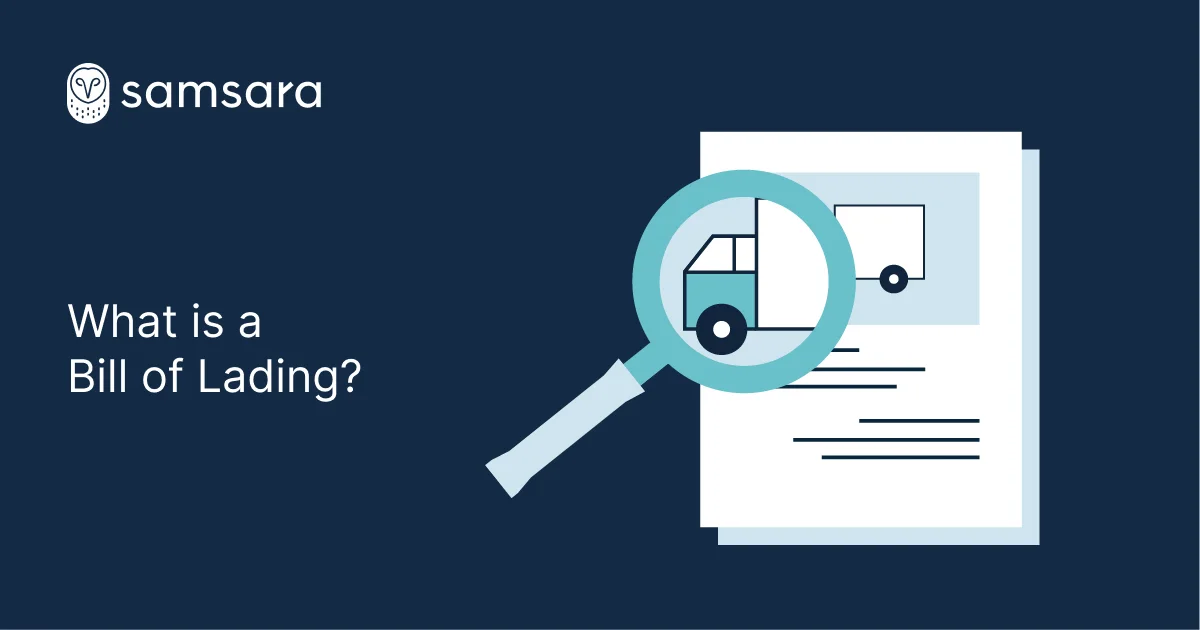What is a Bill of Lading?
October 22, 2021

Get Started With Samsara
Check Our PricesKey Takeaways
While a bill of lading may look like just a list of a shipment’s goods, it’s an important part of the freight transport system. Depending on how freight is shipped, there are different kinds of bills of lading which determine if goods are negotiable or non-negotiable.
What is a bill of lading (BOL)?
A bill of lading (BOL) is a detailed list of a shipment’s goods issued by a carrier to the shipper or consignor. It serves as a contract of carriage for goods with a carrier, freight forwarder, or broker. It also serves as a receipt that cargo has been accepted for transportation. BOLs are considered legal documents and common fleet document.
To note, the bill of lading is different from freight bills/freight invoices. While freight bills should match closely with bills of lading counterparts, an invoice may contain other information such as additional charges or added stipulations. Freight bills will not serve as any proof or evidence in a legal dispute.
Different types of bills of lading
Depending on how the freight is shipped, there are different kinds of bills of lading. Here are a few of the most common types:
Straight bill of lading: This is a non-negotiable BOL used when shipping items are prepaid.
“To order” bill of lading: Used together with a letter of credit to aid the safe transfer of goods between buyer and seller. These bills are used when payment is not made in advance and when the shipment is considered negotiable.
Air waybill: A non-negotiable document used to ship goods by air.
Ocean bill of lading: A negotiable document used to transport goods overseas.
Inland bill of lading: Used for international shipments traveling freight via land or railroad, but not overseas.
Claused bill of lading: Used when cargo is damaged or has missing quantities.
Clean bill of lading: Used when cargo is in good condition; no damage or loss of goods.
Negotiable vs. non-negotiable bills of lading
In negotiable bills of lading, carriers are instructed to deliver goods to anyone who has possession of the original, endorsed copy of the bill. This original endorsed bill signifies the title and control of the freight.
A non-negotiable bill of lading specifies a consignee, receiver, or buyer to whom goods will be shipped and delivered. However, it doesn’t represent the ownership of the goods. The receiver can claim the goods by confirming their identity through other documentation.
What is in a bill of lading?
Bill of lading details includes (but are not limited to):
Shipper (consignor or exporter) name and address: The shipper’s full name, address, and phone number.
Receiver (consignee or importer) name and address: The receiver’s full name, address, and phone number.
Carrier information: Can include carrier name, ID, and contact information.
Purchase orders or reference numbers: Numbers or identification used for freight to be released for pickup or accepted at delivery.
Special instructions: Any special instructions for the shipment. (Handling protocols, liftgate requirements, hazardous materials etc.)
Scheduled pickup and dropoff dates: These may be needed as a reference to track freight.
Description of items: Shippers should include the freight’s dimensions, weight, shipping units, and information about the freight’s makeup.
Packaging: Denotes how the freight is packaged (crates, pallets, drums) and if it’s stackable.
NMFC freight class: The National Motor Freight Classification (NMFC) is a shipping standard that helps compare commodities. Different freight classes will impact how much shipping costs.
Department of Transportation (DOT) hazardous material designation: Any hazmat shipment must be clearly marked with handling instructions detailed.
Declared value: How much the freight is worth. In case the shipment is lost or damaged, declared value helps compensate losses.
Signature lines: Place for all parties—shippers, carriers, and receivers—to sign off.